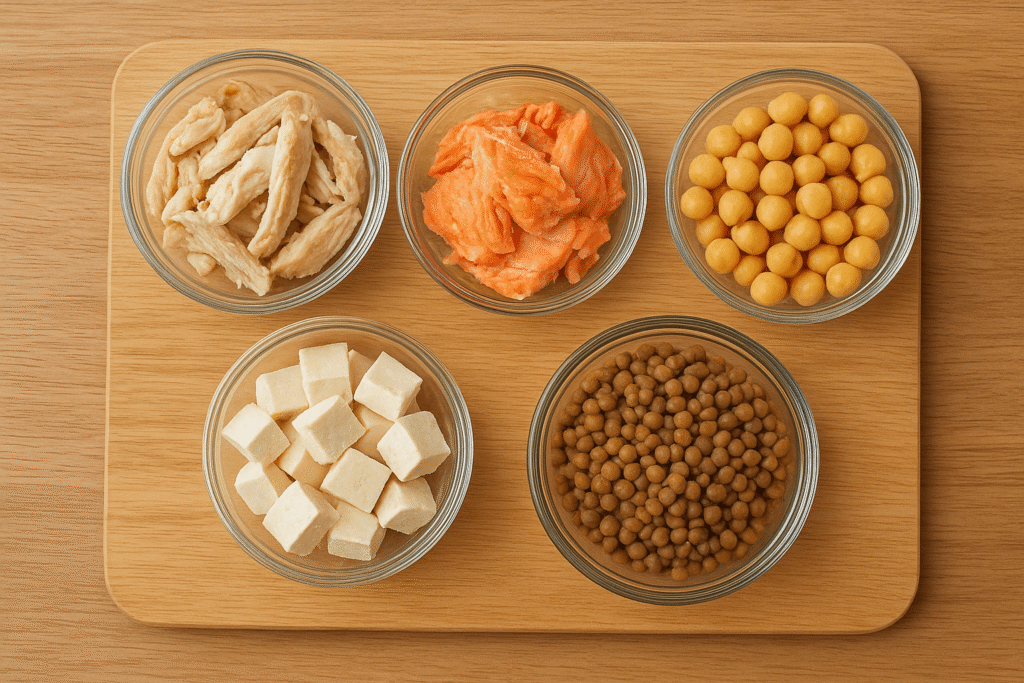Save Money and Eat Healthier with Easy Meal Planning
How Meal Planning Can Make You Happier, Less Stressed, Richer and Healthier
Does that sound like the title of a self-help book? Maybe, but it’s undeniable! Planning the meals of the week will make it so much easier to stick to routines, eat great food and stick to your plan after a draining workday.
By not having to waste energy each weeknight trying to come up with what to cook for dinner you’ll have a lot more energy for other things – things that you enjoy and truly matter to you. Maybe some time to go for a walk or play with your kids. Planning your week’s meals also allows you to buy in bulk and avoid unnecessary trips to the supermarket, ultimately saving you money and reducing stress levels. We recommend that you start your planning on the Sunday the week before.
How do I what meals I need to plan for?
Before you start planning, you need to think a bit about these questions:
- Nutrition
- Composition of meals
- Budget
- Season
- Vegetarian/Meat/Fish/Dairy?
- Batch cooking or cook everyday?
- Bring food box to work or buy lunches?
Let’s go through them one by one.
Nutrition
To function properly and allow us to live a healthy lifestyle, our bodies need energy and the right building blocks. Energy can be counted in calories. Just to stay alive, your body needs approximately 2000 kcal. Depending on your activity level, you need even more calories to replaces the ones you burned during exercise. You can check your calorie needs using an online calculator, such as this one. The point is it’s vital to get enough energy for your activity level. If you are working out several days a week, make sure you get enough. And if your activity level is low or maybe you are struggling with overweight, think about if you need to cut calories.
When it comes to building blocks, there are three main components. Carbohydrates, fat and protein. We all need all three of these to function properly. Additionally we need vitamins and minerals. Let’s break it down below:
Carbohydrates
Carbohydrates are the body’s primary source of energy. Ideally, they should come from complex and slowly digested sources, such as whole grain pasta, oats and legumes. Complex carbohydrates provide a steadier release of glucose. They are also a good source of fiber (read more about fiber later in the article), which has positive effects on digestion, blood sugar regulation and satiety.
Aim for most of your daily carbohydrate intake (generally (45-55% of total energy intake for adults) to come from minimally-processed whole-grain sources rather than simple sugars.
Protein
Protein plays an important role in muscle repair, hormone and enzyme production and immune function. Adults need around 1.2-1.6 g per kg body weight per day depending on activity level (84-112 g for a 70-kg adult). Protein is made up of a smaller building block called amino acids.
Good sources of protein include lean meats such as chicken and turkey, fish, beans, lentils and tofu. Protein quality is also important. By consuming a variety of proteins, sufficient intake of essential amino acids (amino acids that the body cannot synthesise on its own) is ensured.

Fats
Fats support hormone production, help absorb fat-soluble vitamins and provide energy to the body. For cardiovascular health, prioritise unsaturated fats (for example olive or rapeseed oil, nuts, seeds and fatty fish) over saturated fats (butter, cream, tallow and highly processed foods). Think about which fats are solid at room temperature – as a general rule, these fats have a higher level of saturated fat.
Some fats such as omega-3 fatty acids have anti-inflammatory properties and contribute to brain and heart health. They can be found in fatty fish such as salmon or mackerel (ideally 1-2 servings per week).
Vitamins
Vitamins are crucial for metabolic processes such as energy production, immune support and tissue repair. Common deficiencies are vitamin D, folate and vitamin B12 (especially in vegans and vegetarians). A varied diet rich in fruit, vegetables, whole grains and fish typically provides sufficient amounts. Most guidelines recommend prioritising food-based sources over supplements (unless clearly indicated).
How to Compose a Balanced Meal – The Plate Model
A good rule of thumb is the plate model (in Swedish tallriksmodellen) which visually divides the plate into sections based on food groups. This promotes a good mix of macronutrients, fibre, vitamins and minerals in every meal, while remaining flexible to individual needs.
- Half the plate: vegetables and fruit. Fill half your plate with a variety of vegetables, preferably seasonal and colorful. Vegetables can be raw, cooked and fermented. Fruit and vegetables provide fibre, vitamins, minerals and bioactive componds (such as antioxidants).
- One quarter of the plate: protein. Fish, poultry, eggs, legumes, tofu or lean meat. Ensures you meet your daily protein needs for muscle maintenance and growth, satiety and immune function.
- One quarter of the plate: carbohydrates: The last quarter of the plate should be carbohydrates, preferably whole-grain, such as pasta, rice, potatoes, quinoa. These provide energy, fibre and key micronutrients.
- Adjust for activity: If you are physically active, increase the carbohydrate portion and reduce the vegetable portion slightly to support recovery and performance. On less active days, add more vegetables again.
The plate model is not a strict rule but can be used as a flexible guideline to help put together nutritious and balanced meals.
Budget
Based on your income, set aside a monthly grocery budget. This budget can be further divided by four which results in your weekly grocery budget. Say your monthly grocery budget is $400. That means that every week your goal is to plan and shop for the week’s food for no more than $100. Sometimes a challenge, but a fun one that can force you to be creative. Try to mix cheaper (e.g. beans/lentils/tofu/eggs) and more expensive protein sources (fish/meat/poultry), see what’s on offer at your local supermarket, buy in bulk when possible. Use your freezer to store food if you don’t need it right away.
Season
Buy produce that is in season when possible! Not only is it cheaper, but so much better quality. Here’s a guide you can use to see which food is in season in the US, here is another example from Europe.
Dietary preferences
Next step is to decide if you need to take any dietary preferences into account. Are you vegetarian, vegan, gluten intolerant? If so, of course this needs to be considered when meal-planning.
Batch cooking vs. daily cooking
We love a good batch-cooked dinner! When you are cooking, it doesn’t take that much extra effort to double the recipe. Store the extra food in the freezer and bring it out when you have that extra stressful week. Some foods store better in the freezer than others – stews, soups and bread freeze extra well!
However, some weeks having leftovers can be… just not that fun. You might be feeling extra creative, especially if you enjoy cooking. Then it is better to choose daily cooking with different dishes each day. You will enjoy the food more and waste less of it.
Bring Lunch to Work or Buy Daily
This one is also different depending on what you do during the day. For example, in Sweden it is common (at least in the healthcare sector) to bring packed lunches to work. In other sectors, most people buy lunches. I wont get into the economics of it – of course it costs more to buy food every day but it is also something that saves you time and can be seen as a nice treat.
However, if you decide to bring a packed lunch – and you can make it in a nice way – you will find out it doesn’t take that much extra effort. When you are cooking dinner, just make a couple of extra portions depending on how many are in your household and bring it to work/school the next day. Invest in some nice, glass boxes and throw out the crusty old plastic ones that have been colored yellow from a pasta bolognese…
How to plan your meals
Alright, you made it this far! Now you have a good amount of knowledge of what foods are better for your body. Let’s plan the week. First, draw up the days of the week. Then I like to write what category of food we’re having each night. This can be inspired by what’s in season/on offer, but generally it looks something like this:
Monday (Vegetarian), Tuesday (Fish), Wednesday (Chicken), Thursday (Vegetarian), Friday (Meat). Try to have a mix of veg/fish/meat/poultry. Then I like to leave the weekends free. Who know’s what will happen? Maybe you get invited to the neighbourgh’s barbeque, or maybe you are feeling like a pasta night, or maybe you want to try that new restaurant on the Saturday? But I find that it gives me a bit more creative freedom if you leave those days blank.
Next step is to add dishes to each day. Use a recipe bank, Google, use a cookbook, use HelloHelsa’s recipe collection. The possibilities are endless. For example: Monday (Chili sin carne with black beans), Tuesday (Salmon with roasted potatoes and haricot verts) etc. Bonus point if you can buy bulk and use the item for two dishes (= savings). Also, don’t be afraid to skip some ingredients and/or add ingredients you already have at home. With experience you will learn what goes well together.
Shop!
Once you have your weekly list of dishes, combine the ingredients list from the recipes to make a shopping list. Don’t forget breakfast items, healthy snacks etc. We will write an article on both of these as soon as we can. Then, head out to the best grocery store in your area and shop for the whole week. Yes, it will be a more expensive trip than shopping for groceries daily, but in the end you will save a lot of money this way and waste less food.
Only buy what is on your grocery list! It is very easy to be tempted into buying things that are on offer but you don’t really need. And don’t shop when you are hungry 😉
Good job – you made it to the end
That’s it for this article. Now you are ready to plan the meals of the week and cook delicious, healthy food. Soon, we will add nutritious and tasty recipes that you can use when planning. Good luck!
